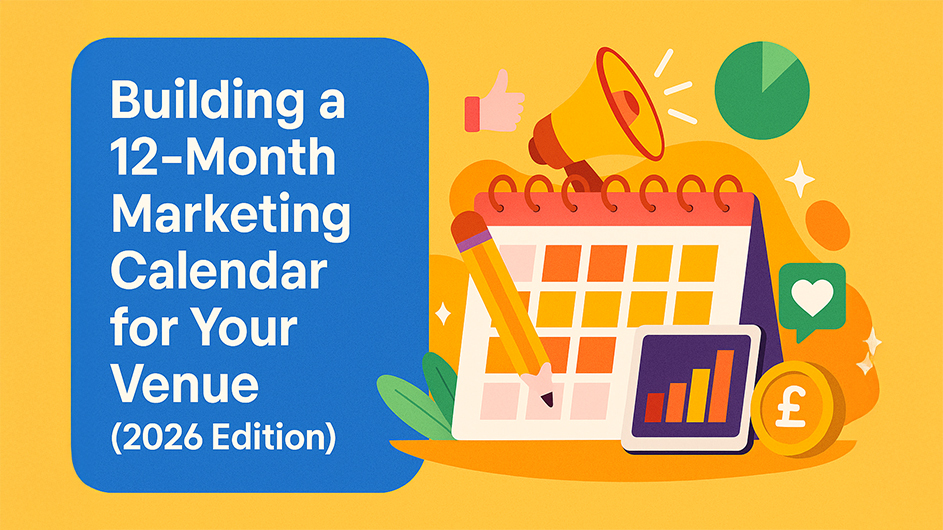Running a successful leisure venue is about more than keeping your calendar full — it’s about knowing when to push, what to promote, and how to stay ahead of competitors. A clear, year-round marketing plan helps you balance seasonal highs, quiet spells, and new opportunities, ensuring consistent revenue and visibility across 2026.
Here’s how to build a 12-month marketing calendar that works.
Start with the Big Picture
Before diving into promotions and campaigns, map out the major seasonal milestones that impact your business. This includes:
-
School holidays (Easter, Summer, Christmas)
-
Bank holidays and long weekends
-
Local events or festivals
-
Weather patterns (great for indoor vs outdoor attractions)
These are your natural peaks — and the foundation of your marketing calendar.
Once you know your busy and quiet periods, you can build around them strategically.
Define Your Key Goals for 2026
Your marketing calendar should align with your business goals. For example:
-
Increasing party bookings by 15%
-
Growing midweek traffic
-
Expanding your corporate or group bookings
-
Launching a new attraction or experience
Setting measurable targets gives purpose to your campaigns and helps track success month by month.
Structure Your Year into Four Seasonal Campaigns
Winter (January – March): Reset and Retain
Focus on:
-
New Year promotions (“New Year, New Adventures”)
-
Off-peak offers to boost quiet weeks
-
Membership and loyalty pushes
-
Valentine’s or February half-term events
💡 Tip: Use January for reflection, data analysis, and planning your big summer campaign.
Spring (April – June): Growth & Launch
Focus on:
-
Easter and May half-term family events
-
Launching new attractions, games, or party packages
-
Local school partnerships and group bookings
-
Promoting early summer offers
💡 Tip: Use brighter visuals and outdoor messaging — guests are itching to get out again.
Summer (July – September): Peak Season & Retention
Focus on:
-
School holiday campaigns
-
Family bundles and upsells
-
Corporate summer socials or team days
-
Social media contests and user-generated content
💡 Tip: Plan daily social content in advance and allocate ad budget for paid reach during the school holidays.
Autumn/Winter (October – December): Events & Festive Magic
Focus on:
-
Halloween, Bonfire Night, and Christmas events
-
Corporate Christmas parties and group bookings
-
Gift cards and experience vouchers
-
New Year’s Eve activities and January pre-booking offers
💡 Tip: Get your Christmas content ready by October — the earlier you launch, the better your results.
Balance Seasonal and Evergreen Content
While seasonal campaigns drive short bursts of traffic, evergreen content (like blog posts, videos, and SEO pages) keeps you visible year-round. Examples include:
-
“Top 5 Birthday Party Ideas in [Your Town]”
-
“What to Do on a Rainy Day in [Region]”
-
“Best Team-Building Activities Near Me”
Mix these in throughout the year to boost organic search and long-term engagement.
Use a Simple Calendar Format
Don’t overcomplicate things — a shared Google Sheet or marketing calendar app is often enough.
Columns to include:
-
Month
-
Campaign name
-
Goal
-
Target audience
-
Channels (email, social, PPC, blog, etc.)
-
Budget
-
Performance notes
Keep it visual and flexible — update regularly based on what’s working.
Plan for Reactive Opportunities
2026 will bring unexpected viral trends, new tech, and cultural moments you can tap into. Leave room in your calendar for reactive marketing — things like:
-
Trending memes or national days
-
Weather-related offers (“Rainy Day Specials”)
-
Spontaneous community events or charity tie-ins
Agility is what turns a good marketing plan into a great one.
Evaluate and Adapt Quarterly
Every three months, review:
-
Campaign performance
-
ROI on paid spend
-
Customer feedback and reviews
-
Social and email engagement
Adjust your strategy for the next quarter — don’t wait until December to pivot.
Final Thoughts
A great marketing calendar isn’t about filling space — it’s about creating rhythm. With a clear, structured 12-month plan, your leisure venue can stay proactive, not reactive, delivering the right messages at the right times to the right people all year long.
Make 2026 the year your marketing works smarter, not harder.
